S2 Perfect competition
1/21
There's no tags or description
Looks like no tags are added yet.
Name | Mastery | Learn | Test | Matching | Spaced |
|---|
No study sessions yet.
22 Terms
Why is it important to know about different market structures?
It helps us evaluate the positive (how much is produced and at what price) and normative (are the positive aspects, in some sense, ‘good’) aspects of the market.
Characteristics of the market affect the way buyers and seller interact.
What are the key features of market structure?
The number of firms in the market e.g. how many producers
The ease with which firms can enter and leave the market (barriers to entry and exit)
If regulations make it difficult for new firms to navigate there are said to be high barriers to entry
If existing firms find it difficult to sell equipment and lay off workers there are said to be high barriers to exit.
The ability of firms to differentiate their products from those of their rivals (product differentiation) due to unique features, premium quality, established brand images, etc.
What are the different types of market structure?
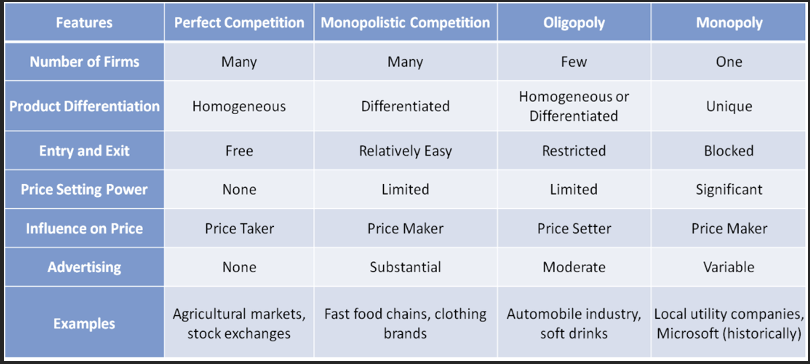
What are examples of imperfect cometition?
Monopolistic, oligopoly and monopoly
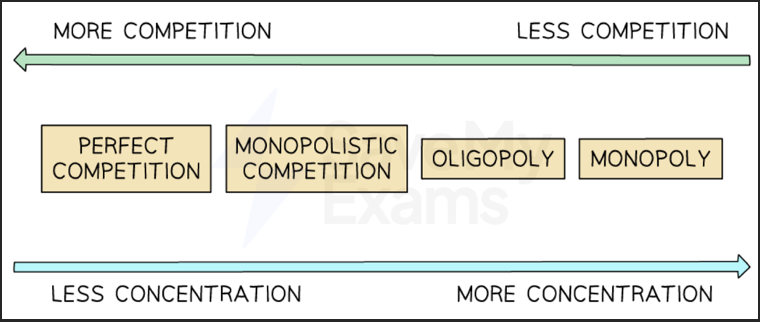
What are the key features of perfectly competitive markets?
Key features of Perfectly Competitive markets:
Many small buyers and sellers
All firms produce identical products
Firms can freely enter and exit the market (free entry and exit)
Buyers and sellers have full information about price and product characteristics
There are negligible transaction costs
What does perfect competition facilitate?
It facilitates competition and prevents firms from exercising any market power.
Why study PC when some of the assumptions maybe unrealistic?
Many markets can be reasonably described as competitive (many agricultural and other commodity markets, stock exchanges, retail and wholesale, construction).
A perfectly competitive market has many desirable properties which are used as a benchmark to compare to real world markets.
Explain the price taking behaviour of perfectly competitive firms
Competitive market structure – many firms produce identical products and firms easily enter and exit the market.
Price taker – each firms takes the market equilibrium price as given).
It can sell as many units as it wants at this price without affecting the market price.
Faces an individual demand curve that is horizontal at the market price.
Marginal revenue (MR) – change in total revenue due to producing one more unit remains constant at P* for an individual competitive firm.
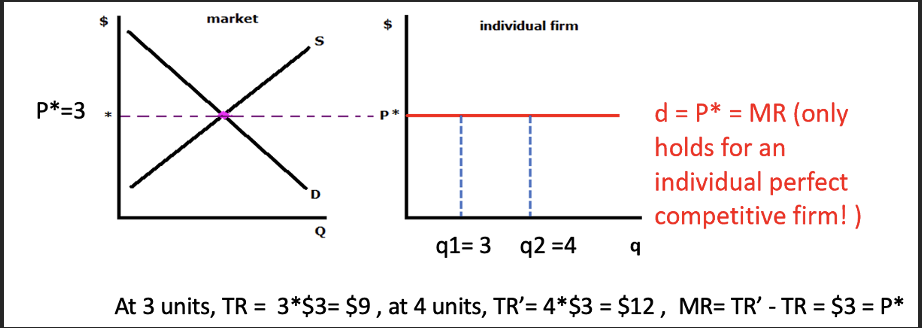
What is a firms objective, and what are the different types of profit?
Firms’ objective is to maximise profits: 𝜋 = TR – TC (𝜋 - Greek letter Pi)
Supernormal profits (positive economic profits) occur when: TR> TC -> P*Q > ATC*Q -> P > ATC
Normal profits (zero economic profits but positive accounting profits) occur when: TR = TC -> P*Q = ATC*Q -> P = ATC
Losses (negative economic profits) occur when: TR < TC -> P*Q < ATC*Q -> P < ATC
Explain the difference between implicit and explicit cost and the difference between economic and accounting cost.
Explicit costs: direct out-of-pocket payments like wages and materials, recorded in financial statements.
Implicit costs: opportunity costs of using owned resources, such as foregone rental income from not renting out durable machinery.
Economic cost = explicit cost + implicit cost
Accounting cost = explicit cost
Economic profit = Total revenue – economic costs
Accounting profit = Total revenue – explicit cost
Economic profit <= accounting profit
What is a firm’s profit function and what must it consider according to this? What is the profit maximisation condition?
Output decision – if the firm produces, what output level, q*, to potentially maximise its profit or minimises its loss?
Shutdown decision – is it more profitable to produce q* or to shut down and produce no output?
Profit Maximisation Condition: for any profit-maximising firm: MR = MC

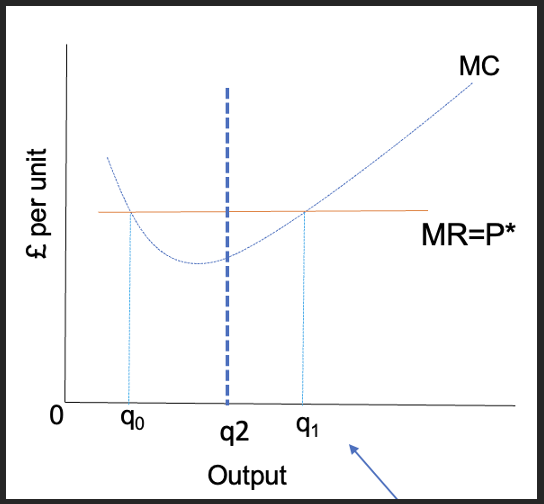
Explain this graph
For a perfectly competitive firm, profit maximization occurs where: P = MC (= MR)
Notice that P is a constant that does not vary with q, while MC does (it’s tick-shaped)
A profit-maximising competitive firm would choose q* where MC rises to the same level as the P*
The firm chooses the quantity only, not the price
Output q1 is a maximum-profit position.
At q2, MR > MC, implying marginal profit > 0. Producing additional units increases total profit
Because the firm faces a horizontal demand curve and the MC curve is often U-shaped, the equality of marginal cost and marginal revenue is not sufficient to identify the profit-maximising output.
Output q1 is a maximum-profit position, since at outputs just below it, marginal revenue exceeds marginal cost and profit can be increased by increasing output towards q1, while at outputs just above it, marginal cost exceeds marginal revenue, and profit can be increased by reducing output towards q1.
Explain the short-run shut down decision for a competitive firm
Does applying P=MC guarantees that the firm would make a positive profit? NO!
We still need to determine AVC and ATC associated with q*
Short run profit = TR(q) –VC(q) – FC
FC are considered sunk costs - already incurred expenses that cannot be recovered - irrelevant to current decision-making.
A firm should weigh TR against VC rather than TC, ignoring the FC
Recall that TR = P*Q, VC = AVC*Q
Short run shut-down condition:
If P≥AVC, should continue operating even if AVC < P < ATC (=AVC+AFC) (making a loss) because operating is better than shutting down.
If P<AVC, the firm should shut down in the SR to minimise loss.
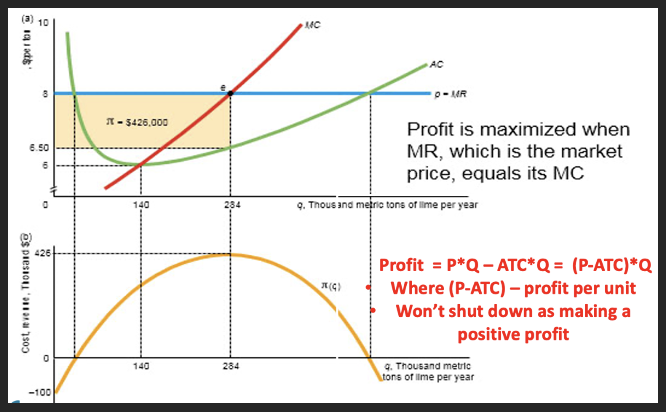
Explain the long-run shut down decision for a competitive firm
Long run profit = TR(q) –TC(q)
A firm should compare TR with TC
If TR> = TC, the firm should continue operation as it makes positive economic profit
If TR<TC, it should shut down completely by exiting the market.
Recall that TR = P*Q, TC = ATC*Q
Long run shut-down condition:
If P≥ATC, the firm can cover all its costs and potentially make a profit, thus it should continue operating.
If P<ATC, the firm should shut down completely in the long run by exiting the market due to inability to cover total costs, leading to losses
How does a competitive firm approach profit maximisation in the short run?
Output Decision - Find the intersection of MR (=P) and MC, which determines the optimal level of output q*
Shutdown decision - Determine the ATC and AVC associated with q* by adding a vertical line passing through q* that intersects ATC and AVC.
i) if P> ATC, then the firm makes a positive profit per unit, of course won’t shut down
ii) However, if AVC <= P <ATC, then the firm would be better off continuing its operation despite making a loss (profit < 0)
iii) If P<AVC (also P<ATC), then should shutdown to reduce loss – if the P dips below the min of AVC -> shut down
Explain the firm’s short-run supply curve
If the price falls below the firm’s minimum average variable cost the firm shuts down.
Thus: the competitive firm’s short-run supply curve is its MC curve above its minimum AVC
In the short run, the maximum number of firms in a market, n, is fixed because new firms need time to enter the market.
If all the firms in a competitive market are identical, each firm’s supply curve is identical, so the market supply at any price is n times the supply of an individual firm.
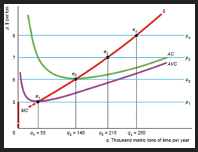
What happens as there are more and more firms?
As the number of firms grows very large, the market supply curve approaches a horizontal line at the minimum point of the AVC curve.
This, the more identical firms producing at a given price, the flatter (more elastic) the short-run market supply curve at that price.
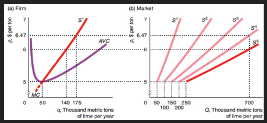
What is the case for economic profits and losses as well as the number of firms in the industry in the short run?
Economic profits or losses can be made by firms
The number of firms in the industry is fixed.
How about in the long run?
Positive economic profits attract other firms, which by entering the market, increase the supply of output and reduce the market price until the existing firms are just covering their costs -> zero economic profits
Losses create an incentive for the exit of firms; the market will contract, driving the market price up until the remaining firms are just covering their costs – zero economic profits
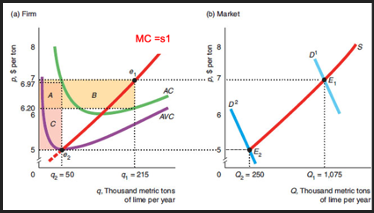
What does free entry in the long-run do?
Drives economic profits to 0.
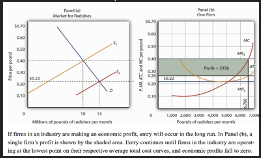
Explain the long-run break-even price
Firms exit an industry when they are making losses and enter when attracted by positive profits.
There is no further entry or exit when firms are just covering all their economic costs.
The long-run equilibrium of a competitive industry occurs when firms (or the marginal firm) are earning zero economic profits/normal profits.
This is when P = min LRAC = LRMC.
Explain zero long-run profit with free entry
One implication of the shutdown rule is that the firm is willing to operate in the long run even if it is making zero profit.
But how can this be?
Because at a zero long-run economic profit (including the opportunity cost), the firms earn just enough profit to cover all their costs, including the opportunity costs of the resources employed, leading to zero economic profit but positive accounting profits.